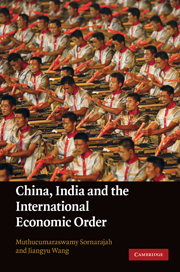Book contents
- Frontmatter
- Contents
- Notes on contributors
- Preface
- Introduction and overview
- PART I China, India and the global trade system
- 1 The WTO and development policy in China and India
- 2 China, India and developing countries in the WTO
- 3 China–India cooperation, South–South coalition and the new international economic order
- 4 India, China and foreign investment
- 5 China, India and WTO Law
- 6 China, India and the WTO dispute settlement system
- 7 China, India and dispute settlement in the WTO and RTAs
- 8 China, India and global outsourcing of services under GATS
- 9 International dispute settlement
- PART II China, India and regional economic integration in Asia
- PART III Law and development in China and India: Domestic issues
- Index
- References
1 - The WTO and development policy in China and India
from PART I - China, India and the global trade system
Published online by Cambridge University Press: 03 May 2011
- Frontmatter
- Contents
- Notes on contributors
- Preface
- Introduction and overview
- PART I China, India and the global trade system
- 1 The WTO and development policy in China and India
- 2 China, India and developing countries in the WTO
- 3 China–India cooperation, South–South coalition and the new international economic order
- 4 India, China and foreign investment
- 5 China, India and WTO Law
- 6 China, India and the WTO dispute settlement system
- 7 China, India and dispute settlement in the WTO and RTAs
- 8 China, India and global outsourcing of services under GATS
- 9 International dispute settlement
- PART II China, India and regional economic integration in Asia
- PART III Law and development in China and India: Domestic issues
- Index
- References
Summary
Introduction
China and India are the two largest developing countries by population and Gross Domestic Product (GDP). Together they account for one third of the world's population and approximately one sixth of the world's GDP. Together, they account for half of the world's poor. They have experienced remarkable growth over the past decade. How does the (WTO) World Trade Organization figure in the further growth of China and India?
Both China and India were original members of the General Agreement on Tariffs and Trade 1947 (GATT). The government of Taiwan purported to withdraw China from the GATT after the 1949 revolution, and China famously acceded to the WTO at the end of 2001. China and India are individually and collectively an important force at the WTO. Their presence is even more critical because of their role as developing countries. However, these two countries demonstrate well that the group of developing countries is diverse, and is not always united in its interests. While China, India and a handful of other large developing countries can be expected to lead the developing country bloc, this bloc includes a good deal of diversity of interest.
- Type
- Chapter
- Information
- China, India and the International Economic Order , pp. 17 - 52Publisher: Cambridge University PressPrint publication year: 2010



